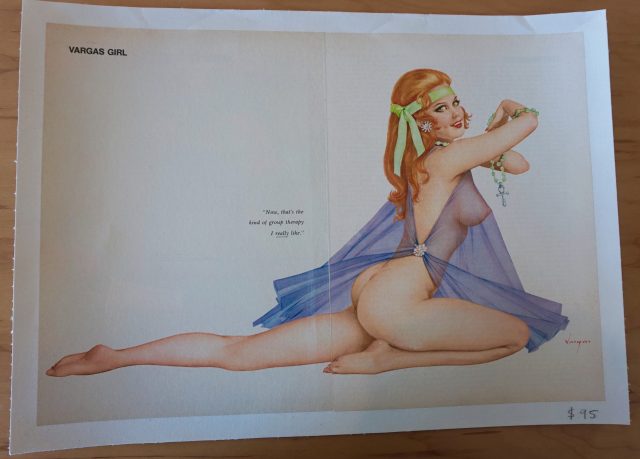Earlier this week, we learned of the death of Playboy founder Hugh Hefner at age 91. A true American original, the pajama-clad Hefner distilled the zeitgeist of Sixties bachelorhood into a publishing empire, and created one of the world’s most recognizable brands. Along the way, he also helped forge a path for one of America’s most beloved artists: Alberto Vargas.
The son of a successful photographer, Vargas was born in the tiny city of Arequipa, Peru in 1896. The illustrator’s origins were humble to say the least, and though his discerning eye was recognized at an early age, no one could have predicted his destiny: to become one of the most well-known artists of the 20th Century.

Memories of Olive, a 1920 Vargas portrait of actress Olive Thomas.
Educated in Europe, the young Vargas was exposed to a wide range of influences, including Dada and Surrealism. But his time in Europe was cut short by the war, and he soon found himself in New York. Employing a combination of watercolor and airbrush, Vargas specialized in idealized images of beautiful young females–healthy, innocent and overtly sexual. Working at first for the Ziegfeld Follies on Broadway, his style quickly became popular among Hollywood studios, and his portrait of actress Olive Thomas from this period is considered one of the first ‘Vargas Girls.’

“Well, you’ve finally convinced me, Mr. Wyngate. I’m ready to throw in the towel.”
During World War 2, Vargas hit his stride. Working primarily for Esquire magazine, he painted 180 iconic pinups between 1940 and 1946. His work was incredibly popular, at least until the people at the U.S. Postal Service decided they didn’t care for it. The post office went after Esquire’s second-class mailing permit, in a case that ended up going all the way to the Supreme Court. And though Esquire eventually prevailed in the suit, they fired Vargas–just to be on the safe side–leading to nearly a decade of struggle for the artist.
[easy-tweet tweet=”What is more beautiful than a beautiful girl? –Alberto Vargas” via=”no” hashtags=”Vargas”]

A young Hugh Hefner cools off during the early 1970s.
In 1959, Vargas was rescued by another Esquire refugee, the publisher whose legend would become inextricably bound to Vargas’ own: Hugh Hefner. Hefner’s trailblazing magazine began using his work in that year, and would do so for another 16 years, restoring the wide audience Vargas had enjoyed during his years at Esquire.
Once considered borderline pornographic, many of Vargas’ works barely register as risqué now. And they showcase the skills of an artist now understood to be a giant. Andrew England, owner of North Beach’s Real Old Paper Gallery, has been collecting Vargas’ work for several years. We had the chance to speak with him about the artist at the gallery early this week.

“One good joint deserves another.” Bear in mind, this was over 50 years ago.
Joe Content: What attracts you so much to Vargas?
Andrew England: I like how detailed they are, the face, the hair, the fashion. It’s not just about the nudity and sexuality. They are also kind of a cool glimpse into the Sixties.
The pinups definitely speak of that period in time. I’m curious: do you know anything about these captions? They are pretty out there.
No, but I do know they are sometimes my favorite thing on some pieces. I always make sure to point them out to people – make sure to read the quotes.

“What I asked you was how you liked my asp, silly.”
They’re not exactly in keeping with today’s progressive attitudes.
No, progressive is not the word I would use (laughter)! You definitely have to look at it with a sense of humor, and understand they were printed in the Sixties–in Playboy magazine.

“Now, that’s the kind of group therapy I really like.”
Along with a superb collection of vintage posters that run the gamut of the art form, England offers a selection of original Vargas pinups for between $50 and $100–making his work accessible to even entry level collectors.
For those interested in learning more about vintage poster art, or about Vargas in particular, England also offers private gallery tours on a first-come, first-served basis. (FYI: Andrew loves locals, and if you mention Joe Content you’ll get a 10% discount.)
Real Old Paper Gallery is open Noon–6:00pm every Tuesday through Saturday. For tour reservations, contact Andrew England at realoldpaper@gmail.com.
.
Real Old Paper Gallery
801 Columbus Avenue
San Francisco, CA
(415) 527-8333